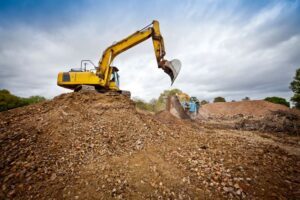Construction
Fears for construction workers after a report found the industry accounted for the most work-related fatalities
There are fears for the safety of construction workers – and the effectiveness of their vehicle safety devices – after a report found the industry accounted for the most work-related fatalities.
The report, released by the Health and Safety Executive (HSE), analysed the cause of death of 123 workers that had been reported under the Reporting of Injuries, Diseases and Dangerous Occurrences Regulations between April 2021 and March 2022.
It found being struck by a moving vehicle the second most common cause of death.
Technology company Brigade Electronics has now called on industry leaders to ensure commercial vehicle safety devices are fit for purpose.


Credit: Alamy Stock
Emily Hardy, Marketing Manager at Brigade Electronics, said: “Many countries are committing to making it compulsory for safety devices to be fitted to vehicles, and this has helped the number of work-related deaths caused by moving vehicles to decrease, but there is still more that can be done.
“Heavy duty industries, such as construction, agriculture, quarrying and mining, operate in some of the most demanding environments.
“Equipment – especially safety equipment – needs to be able to cope with extreme weather, debris, dust and unstable ground.
“We are encouraging fleet, plant and transport managers to take the environment into consideration when selecting safety devices to install onto construction equipment and machinery.”
In the construction industry the size of vehicles and machinery means visibility can be limited for operators and complex blind spots – combined with tough conditions on construction sites – can be a major contributing factor to collisions.
Safety technologies designed to alleviate the increased risk of working in construction environments – such as obstacle detection systems, cameras and monitors and reversing and warning alarms – have been developed but Brigade Electronics want managers to ensure they are fit for purpose.
Emily Hardy added: “Before selecting a device, managers need to look at the scenarios the safety products have been tested in.
“Have devices been put through rigorous assessments in multiple settings and proved to be waterproof, dustproof and shockproof, and effective in extremely low or high temperatures?
“Fleet, plant and transport managers must be confident that the safety devices they install are tough, durable and reliable, and will protect their workers during the type of conditions experienced on construction sites.”
[vc_row][vc_column width="2/3"][vc_column_text]
The Safety Conversation Podcast: Listen now!
The Safety Conversation with SHP (previously the Safety and Health Podcast) aims to bring you the latest news, insights and legislation updates in the form of interviews, discussions and panel debates from leading figures within the profession.Find us on Apple Podcasts, Spotify and Google Podcasts, subscribe and join the conversation today![/vc_column_text][vc_empty_space height="15px"][vc_btn title="Listen here!" color="success" link="url:https%3A%2F%2Fwww.shponline.co.uk%2Fthe-safety-and-health-podcast%2F|target:_blank"][/vc_column][vc_column width="1/3"][vc_single_image image="91215" img_size="medium"][/vc_column][/vc_row]
Fears for construction workers after a report found the industry accounted for the most work-related fatalities
There are fears for the safety of construction workers - and the effectiveness of their vehicle safety devices - after a report found the industry accounted for the most work-related fatalities.
Safety & Health Practitioner
SHP - Health and Safety News, Legislation, PPE, CPD and Resources Related Topics
Recycling company fined £1.2m after worker hit by a wagon
Shipping Services company fined after worker loses finger
Company and director fined after workers exposed to asbestos

Fears for construction workers after a report found the industry accounted for the most work-related fatalities. Yes & this government want to cut many of the H&S regulations.
Unfortunately, whilst projects are commercially driven and programmes are incredibly tight the lack of segregation of plant and pedestrians will continue placing workers at risk as we’ve seen over the last couple of months in the industry.
Whilst I agree potentially cutting regulations is a massive cause for concern which will only influence unscrupulous operators to continue to show a flagrant disregard for the law. However, this is not a sole influencer for the failings that lead to or will contribute to unsafe sites. The failure to effectively plan and organise the work MUST be uppermost in the actions of the people that have the influence over the way a project is managed and delivered. As they say, a diamond is worthless until it has been polished and then it becomes priceless, safety is a journey and everyone MUST play their part. There MUST never be any glass ceiling divides between the boardroom ( the policy creators) and the coal face!! If we keep doing what we are doing, then we’ll keep getting what we are getting. Effective design of site to separate PPI is the most effective and practical approach for safeguarding workers. As a Construction tutor myself, I cannot overstate to my learners ( supervisors and site managers) the importance of a robust site traffic management plan to segregate PPI.